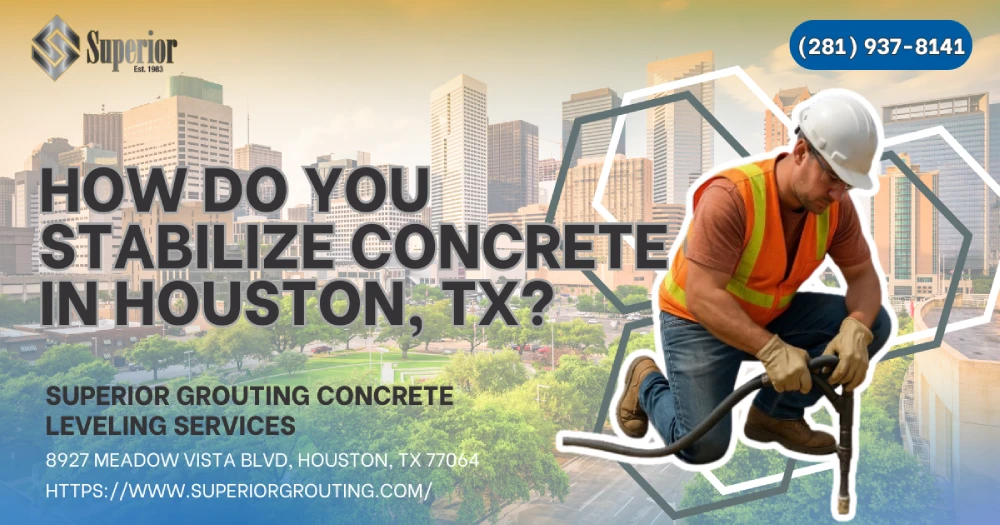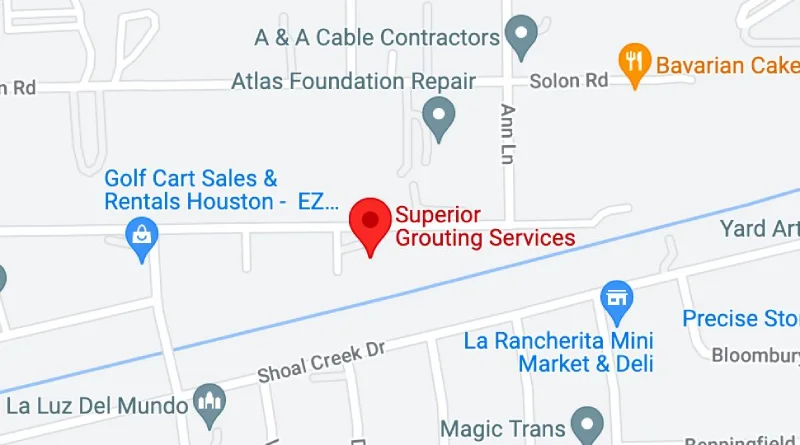How Do You Stabilize Concrete in Houston, TX?

Houston’s soaring heat, torrential rain, and notorious expansive clay can turn a perfectly flat concrete surface into a lumpy liability almost overnight. If you manage a warehouse, distribution yard, refinery, or heavy-haul roadway, you know that uneven slabs create safety hazards, slow productivity, and drain maintenance budgets.
This in-depth guide explores every major concrete stabilization technique available in Houston, TX—polyurethane foam injection, traditional mudjacking, chemical soil stabilization, and deep foundation options—so you can choose the right fix the first time and keep operations on schedule.
Key Takeaways
- Houston concrete stabilization hinges on diagnosing expansive clay cycles and groundwater movement.
- Polyurethane foam injection offers rapid lift, minimal downtime, and almost no added load—a huge plus for soft subgrades.
- Mudjacking can be cost-effective on thick industrial pavements but adds weight that may accelerate future settlement if drainage is poor.
- Chemical soil stabilization (lime, cement, or geopolymer) targets the root issue by boosting load-bearing capacity of Houston clays.
- Accurate testing—GPR scanning, dynamic cone penetrometer data, and elevation mapping—ensures a custom repair plan rather than guesswork.
- Seasoned contractors who understand Gulf Coast regulations, port logistics, and hurricane-grade drainage deliver safer, longer-lasting results.
Why Houston’s Soil Plays Rough With Concrete
Houston sits atop layers of Montmorillonite-rich clay that can swell up to 15% in volume when saturated. During hurricane season downpours, the clay absorbs water, expands, and heaves concrete upward. In dry spells, moisture evaporates, the clay shrinks, and voids form beneath the slab. Heavy wheel loads from forklifts, reach stackers, or semi-trailers then break the weakened surface, requiring costly shutdowns for repair.
Add the region’s high water table, occasional flash floods, and constant temperature swings—often topping 100 °F on the pavement—and you’ve got a perfect recipe for differential settlement. That’s why industrial concrete stabilization in Houston is never one-size-fits-all; it must counter moisture fluctuations, expansive soils, and traffic patterns simultaneously.
Warning Signs Your Slab Needs Stabilization
- Trip lips or sudden height differences of ¼ in. or more at control joints
- Rocking slabs under forklift traffic
- Cracking radiating outward from heavily loaded areas
- Ponding water along joints, hinting at drainage problems
- GPR scans showing voids larger than two inches beneath critical wheel paths
- Premature joint sealant failure due to slab movement
Spot these early and you’ll pay a fraction of the price compared to emergency shutdown repairs.
Comparing Industrial Concrete Stabilization Techniques in Houston
Polyurethane Foam Injection
- Material: Two-part expanding polyurethane
- Lift accuracy: ±⅛ in.
- Time to re-open: 15–30 min
- Added soil load: Negligible (2–4 lb/ft³)
- Best for: Distribution centers, airport aprons, refinery slabs, port pavements
- Key advantages: Lightweight, fast cure, waterproof, strong bond to concrete
Polyurethane foam injection (also called polyurethane concrete lifting or polyjacking) involves drilling ⅝-inch holes, installing packers, and injecting a heat-activated resin that travels through cracks, expands, and gently lifts the slab. Because the cured foam is closed-cell, it repels water—critical in high-water-table zones near the Ship Channel. The lightweight nature of the foam means you solve settlement without burdening weak clays with additional weight.
Traditional Mudjacking
- Material: Cement-sand-water slurry with additives
- Lift accuracy: ±¼ in.
- Time to re-open: 24–48 hr
- Added soil load: High (90–110 lb/ft³)
- Best for: Extra-thick industrial pavements, large parking aprons with limited budget
- Key advantages: Familiar process, lower material cost per cubic foot
Mudjacking (or pressure grouting) pumps a dense slurry that fills voids and pushes the slab up. While proven, the additional weight can trigger future settlement in Houston’s clay if drainage isn’t corrected or if the subgrade remains weak. Still, for massive slabs thicker than 10 in. where material volume dominates cost, mudjacking remains a viable option.
Chemical Soil Stabilization
- Material: Lime, Portland cement, fly-ash blends, or geopolymer
- Lift accuracy: N/A (focuses on soil)
- Time to re-open: Varies—often next day for lime, immediate for geopolymer
- Added soil load: Stabilizes rather than loads
- Best for: Container yards, heavy-haul roads, crane pads requiring higher CBR
- Key advantages: Increases bearing capacity, lowers plasticity index, reduces moisture cycling
By mixing lime or cement into clay, pozzolanic reactions stiffen the soil, enhancing bearing capacity and moisture resistance. Geopolymer injections offer a newer approach: low-viscosity resins penetrate the soil matrix, then solidify into a rock-like lattice that seals voids and blocks water migration. Combining soil stabilization with foam lifting can fix both the symptom and the cause.
Deep Foundation Options (Helical Piles & Slab Brackets)
- Material: Steel helical piers anchored into stable strata
- Lift accuracy: Highly precise—structural support
- Time to re-open: Same day after torque verification
- Added soil load: None (transfers load to deeper layers)
- Best for: Equipment pads, tank bases, or areas with chronic settlement near bayous
- Key advantages: Bypasses problem soils entirely, provides permanent structural support
Step-By-Step Polyurethane Foam Injection Process
- Engineer reviews GPR images, soil borings, and elevation data to design lift points.
- Crews grid the slab, drill ⅝-inch access holes, and install mechanical packers sealed with O-rings.
- Heated hoses deliver precisely metered A & B components into each hole; foam expands immediately, filling voids.
- Technicians watch dial indicators or laser levels for controlled lift, stopping once elevation is restored.
- Holes are patched with rapid-set, non-shrink grout; joints may be re-sealed the same shift.
- Floor, roadway, or apron is reopened within 30 minutes—ideal for 24/7 logistics hubs that can’t afford downtime.
Soil Stabilization Solutions for Houston’s Expansive Clay
Lime Treatment
Quicklime at 4–7 % by weight dries wet subgrades and initiates chemical bonding that lowers the Plasticity Index (PI) drastically. Lime stabilization is popular for new construction of heavy-haul lanes because it provides immediate dry-back and long-term strength gains.
Cement Modification
Cement slurry mixed into the upper 12–16 in. of subgrade ramps up compressive strength, handles repeated wheel loads, and pairs well with roller-compacted concrete overlays. It’s also compatible with fast-track paving schedules at petrochemical terminals.
Geopolymer Injection
Geopolymer resins combine the speed of polyurethane with the soil-strengthening effect of cement. The low viscosity allows deep penetration, and once cured, the geopolymer forms a rigid, waterproof column that cuts off water migration—perfect for high-water-table districts along Buffalo Bayou.
Diagnostics: The Cornerstone of an Effective Repair
Skipping diagnostics is the fastest route to a failed repair. Superior Grouting uses:
- Ground-Penetrating Radar to map voids and locate underground utilities
- Dynamic Cone Penetrometer tests to profile bearing capacity every foot
- Moisture probes and laboratory Atterberg limits to gauge clay plasticity
- 3D laser scanning for millimeter-level elevation mapping
Armed with this data, engineers can recommend foam, slurry, soil stabilization—or a hybrid solution—with confidence.
Cost Factors When Budgeting Industrial Concrete Stabilization
- Scope: Square footage, thickness, and target lift drive material volume.
- Access: Open yards cost less; crowded refinery corridors require night work or extended hoses.
- Material selection: Polyurethane costs more per pound but slashes downtime costs; mudjacking saves on materials but may require longer closures.
- Logistics: Permit fees, traffic control, and water management plans add line items.
- Lifecycle ROI: A $90K foam lift that lasts ten years often beats a $55K slurry job that fails in three.
Factor lost production, labor overtime, and safety risks into your ROI calculation—not just initial vendor quotes.
Choosing a Houston Concrete Stabilization Contractor
- Verify polyurethane or geopolymer certification and OSHA-30 training.
- Request project profiles for petrochemical sites, port terminals, or intermodal yards—proof of Gulf Coast experience.
- Ensure crews own calibrated flow meters, dust-controlled drill rigs, and vacuum extraction systems.
- Require written safety plans, low-VOC material data sheets, and disposal documentation for any spoils.
The right partner will speak fluent “Houston”—understanding high humidity, corrosive salt air near the bay, and hurricane-ready scheduling.
The Bottom Line
Expansive clay, extreme weather, and heavy traffic make Houston one of the toughest places to keep concrete level. But with accurate testing, proven stabilization methods, and a contractor who knows Gulf Coast soils, you can safeguard your slabs, protect personnel, and keep revenue rolling.
Whether you select polyurethane foam for rapid lift, mudjacking for bulk fill, or chemical soil stabilization for long-term strength, Superior Grouting has the expertise to turn unstable ground into solid support—today, tomorrow, and through the next Texas summer.


